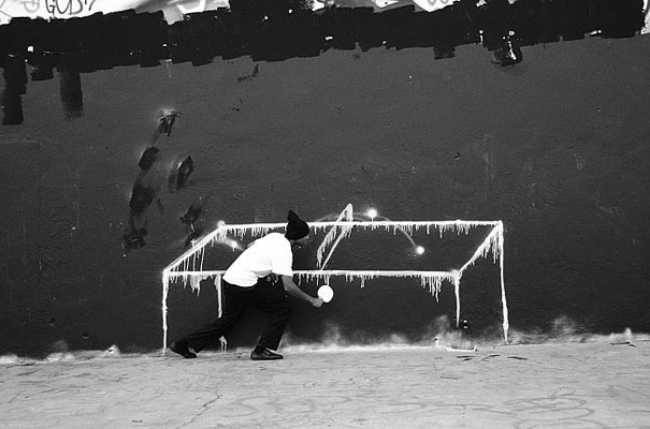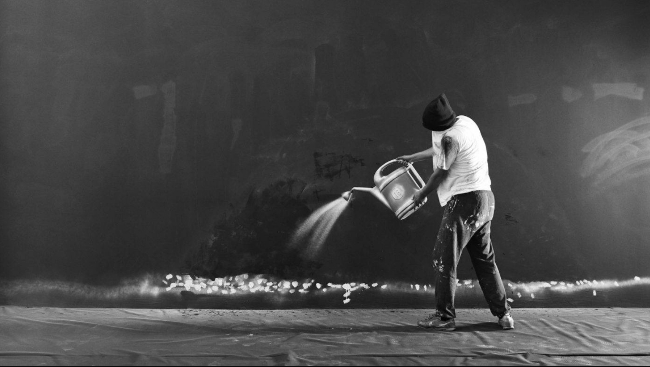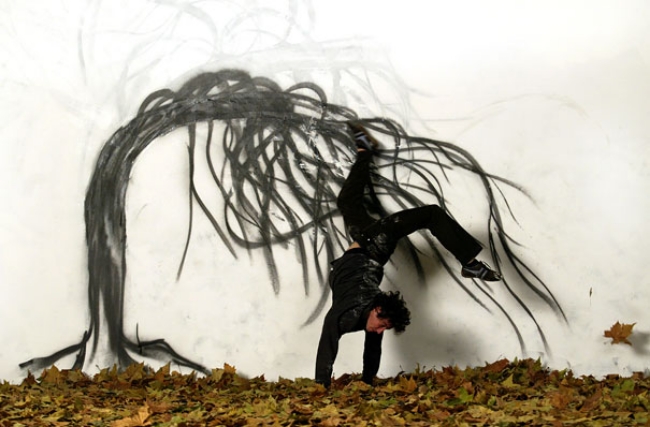Robin Rhode is a smart-ass. One of those young street-punk kids who wants to take on the Art World and kick it in the cojones. And sometimes he really does it; sometimes he seriously lays one right in the goolies (and I’ll give an example later). Most often, though, he makes art at the same time he mocks it.
I love this guy.
Born in Cape Town, South Africa in 1976 (he currently resides in Berlin), Rhode has described himself a “working class bushie artist”. On the surface, his photographic work is remarkably simple. He takes a bit of chalk, sketches out a crude but recognizable object, then he interacts with it as though the sketch was three-dimensional. Brilliant in its simplicity. Part of the brilliance comes from the fact that he makes no attempt to represent the object realistically. It’s not about fooling the viewer’s eye; it’s about engaging the viewer’s imagination.

There is a wonderful sense of playfulness to much of Rhode’s work. It’s a puckish sort of playfulness, no mistake–tongue firmly planted in cheek and full of mischief.
“My scenarios speak of trying to fit into standards and frameworks that are devised by others, situations devised for exclusions, set up‘s for failure. I use humour and play to destabilise and admit the unseemly, expressing the desire to analyse, change, fictionalise and create alternative solutions for situations that are totally dominated by politics and market strategies.”
Some that of that–perhaps much of it–is intellectual bullshit artspeak, of course, but after you translate it into English, it rings true. His art doesn’t fit tidily into any traditional artistic genre. It truly does encourage people to find other (preferably subversive) modes of creativity outside the structured limits of traditional art. By using humor, Rhode does manage to puncture some of the pomposity of traditional art. And by creating his scenarios in venues that can’t be translated easily into the gallery or museum, he is participating in a sort of war of liberation against traditional art.
Then he issues a traditional artspeak artist’s statement. A smart-ass, I’m telling you. And I say it again: I love this guy.

Many of the still images shown here (or that can be found in various locations around Teh Googleverse) are taken out of context from a series of sequential photographs. For example, Harvest (seen below) actually consists of dozens of shots (presented as video in galleries) in which Rhode is depicted tossing sketched seeds onto the ground. He then waters the seeds (using a real watering can that pours sketched water), which causes the seeds to grow into plants. As seen in the photo here, Rhode then takes a real scythe and harvests the sketched plants, which he then uses to construct a sketched bed. He tosses a real sheet over the bed, then lays down to sleep among the remains of the plants.

I’m telling you, I love this guy.
Rhode also created a series of images with a sketched basketball hoop and himself using a real basketball that depict a fantastical dunk shot. Nike, it appears, essentially stole the concept and used it in a television commercial. There is some delicious irony at work there–one of the most consciously branded multi-national corporations ‘liberating’ the work of an avowed street artist in order to give some street cred to a television commercial.
There is also a certain brilliance in basing his work on chalk. Chalk is cheap. It’s possibly the most ephemeral of artistic media; it simply doesn’t last. A single good rain will wash it all away. The transitory nature of the work gives it a sort of Buddhist appeal. The art is both fragile and powerful, and at the same time it’s perfectly cheeky.
That cheekiness was most apparent with his piece entitled Leak, presented at the South African National Gallery. Rhode sketched a urinal on the wall of the gallery (in chalk, of course), then proceeded to urinate in it. He signed the ‘work’ R. Moet (which is apparently the Afrikaans spelling of R. Mutt, the pseudonym used by Marcel Duchamp on his famous urinal sculpture). With that single act, Rhode not only made a pointed artistic statement and a clever reference to art history, he also effectively expressed his opinion of commodified art and at the same time used a time-honored, biologically-sound method of marking his territory. And that, folks, is kicking the Art World right in the goolies.
I love this guy.

Just when you think he’s all attitude and artistic shenanigans, Rhode creates a work of strange beauty. With the Storyteller series, Rhode discards action for a poetic narrative. He uses a chalked tree to tell the story of a man who wants to draw power from the tree. The tree rejects him and he assaults it, which causes the tree to bend and twist as if in a storm, tossing the man around in a welter of cast-off leaves. In the end, the man is engulfed in the darkness of the storm.
In a way, that’s an apt metaphor. It depicts what happens to so many young artists who attempt to struggle with the commodification of art. Rhode, on the other hand, has no desire to engage in that sort of power struggle. Instead, with his low-tech, minimalist, mischief-based art, he uses the insurgent’s approach. Rather than directly confront the overwhelming superiority of the dominant culture, he takes an oblique approach. Like all insurgents, he uses simple, readily available to tools with devastating effect. In effect, Rhode is creating IEDs to use against the marketing of art.
But he’s not trying to bring down the Art World; he’s not trying to destroy it. He’s just trying to puncture it and let some of the gas out.
I love this guy.
